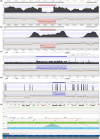The current benefit of genome sequencing compared to exome sequencing in patients with developmental or epileptic encephalopathies
- PMID: 36785910
- PMCID: PMC10178799
- DOI: 10.1002/mgg3.2148
The current benefit of genome sequencing compared to exome sequencing in patients with developmental or epileptic encephalopathies
Abstract
Background: As the technology of next generation sequencing rapidly develops and costs are constantly reduced, the clinical availability of whole genome sequencing (WGS) increases. Thereby, it remains unclear what exact advantage WGS offers in comparison to whole exome sequencing (WES) for the diagnosis of genetic diseases using current technologies.
Methods: Trio-WGS was conducted for 20 patients with developmental or epileptic encephalopathies who remained undiagnosed after WES and chromosomal microarray analysis.
Results: A diagnosis was reached for four patients (20%). However, retrospectively all pathogenic variants could have been detected in a WES analysis conducted with today's methods and knowledge.
Conclusion: The additional diagnostic yield of WGS versus WES is currently largely explained by new scientific insights and the general technological progress. Nevertheless, it is noteworthy that whole genome sequencing has greater potential for the analysis of small copy number and copy number neutral variants not seen with WES as well as variants in noncoding regions, especially as potentially more knowledge of the function of noncoding regions arises. We, therefore, conclude that even though today the added value of WGS versus WES seems to be limited, it may increase substantially in the future.
Keywords: diagnostic yield; epileptic encephalopathy; whole exome sequencing; whole genome sequencing.
© 2023 The Authors. Molecular Genetics & Genomic Medicine published by Wiley Periodicals LLC.
Conflict of interest statement
The authors declare that they have no conflict of interest.
Figures


Similar articles
-
Whole Genome Sequencing in the Evaluation of Fetal Structural Anomalies: A Parallel Test with Chromosomal Microarray Plus Whole Exome Sequencing.Genes (Basel). 2021 Mar 6;12(3):376. doi: 10.3390/genes12030376. Genes (Basel). 2021. PMID: 33800913 Free PMC article.
-
Whole-genome sequencing offers additional but limited clinical utility compared with reanalysis of whole-exome sequencing.Genet Med. 2018 Nov;20(11):1328-1333. doi: 10.1038/gim.2018.41. Epub 2018 Mar 22. Genet Med. 2018. PMID: 29565419
-
Whole-genome sequencing is more powerful than whole-exome sequencing for detecting exome variants.Proc Natl Acad Sci U S A. 2015 Apr 28;112(17):5473-8. doi: 10.1073/pnas.1418631112. Epub 2015 Mar 31. Proc Natl Acad Sci U S A. 2015. PMID: 25827230 Free PMC article.
-
Added Value of Reanalysis of Whole Exome- and Whole Genome Sequencing Data From Patients Suspected of Primary Immune Deficiency Using an Extended Gene Panel and Structural Variation Calling.Front Immunol. 2022 Jun 30;13:906328. doi: 10.3389/fimmu.2022.906328. eCollection 2022. Front Immunol. 2022. PMID: 35874679 Free PMC article. Review.
-
Are whole-exome and whole-genome sequencing approaches cost-effective? A systematic review of the literature.Genet Med. 2018 Oct;20(10):1122-1130. doi: 10.1038/gim.2017.247. Epub 2018 Feb 15. Genet Med. 2018. PMID: 29446766
Cited by
-
Whole Genome Sequencing Solves an Atypical Form of Bardet-Biedl Syndrome: Identification of Novel Pathogenic Variants of BBS9.Int J Mol Sci. 2024 Jul 30;25(15):8313. doi: 10.3390/ijms25158313. Int J Mol Sci. 2024. PMID: 39125883 Free PMC article.
-
Lost in .*VCF Translation. From Data Fragmentation to Precision Genomics: Technical, Ethical, and Interpretive Challenges in the Post-Sequencing Era.J Pers Med. 2025 Aug 20;15(8):390. doi: 10.3390/jpm15080390. J Pers Med. 2025. PMID: 40863452 Free PMC article. Review.
-
Validation of targeted next-generation sequencing panels in a cohort of Polish patients with epilepsy: assessing variable performance across clinical endophenotypes and uncovering novel genetic variants.Front Neurol. 2024 Jan 12;14:1316933. doi: 10.3389/fneur.2023.1316933. eCollection 2023. Front Neurol. 2024. PMID: 38328757 Free PMC article.
-
Utility of Genome Sequencing After Nondiagnostic Exome Sequencing in Unexplained Pediatric Epilepsy.medRxiv [Preprint]. 2024 Aug 9:2024.08.08.24307445. doi: 10.1101/2024.08.08.24307445. medRxiv. 2024. PMID: 39148850 Free PMC article. Preprint.
-
Genome Sequencing After Exome Sequencing in Pediatric Epilepsy.JAMA Neurol. 2024 Dec 1;81(12):1316-1318. doi: 10.1001/jamaneurol.2024.3582. JAMA Neurol. 2024. PMID: 39432277
References
-
- Barbitoff, Y. A. , Polev, D. E. , Glotov, A. S. , Serebryakova, E. A. , Shcherbakova, I. V. , Kiselev, A. M. , Kostareva, A. A. , Glotov, O. S. , & Predeus, A. V. (2020). Systematic dissection of biases in whole‐exome and whole‐genome sequencing reveals major determinants of coding sequence coverage. Scientific Reports, 10, 2057. 10.1038/s41598-020-59026-y - DOI - PMC - PubMed
-
- Begemann, A. , Acuña, M. A. , Zweier, M. , Vincent, M. , Steindl, K. , Bachmann‐Gagescu, R. , Hackenberg, A. , Abela, L. , Plecko, B. , Kroell‐Seger, J. , Baumer, A. , Yamakawa, K. , Inoue, Y. , Asadollahi, R. , Sticht, H. , Zeilhofer, H. U. , & Rauch, A. (2019). Further corroboration of distinct functional features in SCN2A variants causing intellectual disability or epileptic phenotypes. Molecular Medicine, 25, 6. 10.1186/s10020-019-0073-6 - DOI - PMC - PubMed
-
- Bramswig, N. C. , Lüdecke, H.‐J. , Hamdan, F. F. , Altmüller, J. , Beleggia, F. , Elcioglu, N. H. , Freyer, C. , Gerkes, E. H. , Demirkol, Y. K. , Knupp, K. G. , Kuechler, A. , Li, Y. , Lowenstein, D. H. , Michaud, J. L. , Park, K. , Stegmann, A. P. A. , Veenstra‐Knol, H. E. , Wieland, T. , Wollnik, B. , … Wieczorek, D. (2017). Heterozygous HNRNPU variants cause early onset epilepsy and severe intellectual disability. Human Genetics, 136(7), 821–834. 10.1007/s00439-017-1795-6 - DOI - PubMed
-
- Chintalaphani, S. R. , Pineda, S. S. , Deveson, I. W. , & Kumar, K. R. (2021). An update on the neurological short tandem repeat expansion disorders and the emergence of long‐read sequencing diagnostics. Acta Neuropathologica Communications, 9(19), 98. 10.1186/s40478-021-01201-x - DOI - PMC - PubMed
Publication types
MeSH terms
LinkOut - more resources
Full Text Sources
Medical
Research Materials

